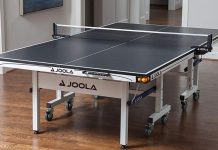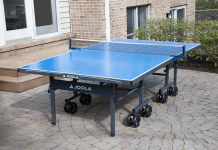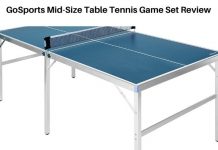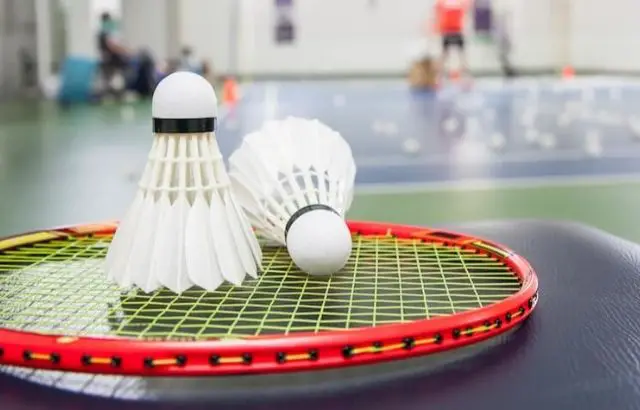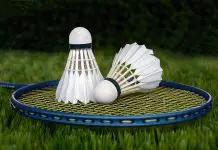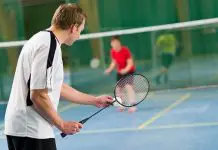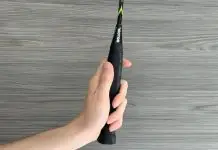Badminton is a very friendly sport as anyone can participate by observing certain games. In this guide, I will explain what are the basic skills of badminton.
Playing this game will give you a rush of enthusiasm, though you will not enjoy it without basic badminton skills. With skillfulness, you will be able to compete and make a name for yourself.
Some basic badminton skills are easier to learn, while some take time to master. It depends on how you catch it and effectively put it into practice. The earlier you can learn, the more you can improve your skills.
To hit different badminton shots, your experience in some basic skills is compulsory. You can’t look forward to becoming a skilled player with bad basics.
Therefore, you need to work on your basics regularly. Improving your skills will motivate you to become a professional player.
There aren’t many badminton techniques out there that make the game fairly easy to master. Sounds good? No, unless you practice!
Table of Contents
What are the Basic Skills of Badminton?
Here is a simplified rundown of the basic skills of badminton. Please take a look at it!
Warm-up properly before start playing badminton
Be active to warm-up before starting. Do basic shooting practice with the goalkeeper without the shuttlecock. Warm up properly before stepping on court for a match or practice, and be sure to also warm up your basic skills as well.
Do high-speed basic practice with the coach, or have the players warm up on their own before playing matches. Stepping up to play without properly warming up beforehand can lead to injury, so be sure to break a sweat as soon as you begin playing. Warm-ups should also include throwing and catching drills with the coach.
Keep your sense of action when doing any sort of training; listen over a headset while watching over others’ exercises, or do some light exercise yourself during breaks for other members to catch their breath so that they don’t slip in concentration.
Here are some simple routines that really get the blood pumping:
- Warm-up with a light run around the court at 30 to 40 percent power, followed by some stretching on your back and sides.
- Warm up with a set of high-speed serves (for 1 minute), then do some fast passing drills (10 minutes in all). Doing these will warm up your whole body and get your shuttlecock control up to a good level.
- Warm up with stretching and a light jog, then throw or catch the shuttlecock (1 minute), and do more passing drills (10 minutes in all). Warm-up by yourself before playing your doubles match.
- Warm up with some basic receiving and serving practice, then follow that with some serves and volleys at full power for five minutes each. Be sure to stretch thoroughly after this drill is over; try not to get overtired while on the court because it’ll be harder to properly relax when warming down afterward.
- Warm up with some basic footwork drills from 50 steps away, followed by a game of “tennis” using the shuttlecock. Warm up properly before stepping on court for a match or practice, and be sure to also warm up your basic skills as well.
- Spend at least five minutes both before and after practice concentrating solely on stretching, so that muscles won’t stiffen later because you hadn’t been cooling down regularly enough.
Do high-speed basic practice with the coach, or have the players warm up on their own before playing matches. Stepping up to play without properly warming up beforehand can lead to injury, so be sure to break a sweat as soon as you begin playing. Warm-ups should also include throwing and catching drills with the coach. Keep your sense of action when doing any sort of training; listen over a headset while watching over others’ exercises, or do some light exercise yourself during breaks for other members to catch their breath so that they don’t slip in concentration.
Hold the racket properly.
In badminton, this skill is essential for the player. The way you hit the shot depends on how you catch the racket. Wrong holding will drive the shuttlecock in the wrong direction, and your service will not be on the mark.
To hold the racket properly, think of the grip of the racket as someone’s hand. Like a firm handshake, hold the grip in such a way like you hold a person’s hand.
Please do not hold the racket too tightly, as it will ruin the comfort of your wrist and adversely affect your performance. Slowly press the thumb against the grip’s wide surface and hold the racket with the rest of your hand.
Learn Basic Shots
Badminton players generally rely on basic shots to score. The basic strokes include the forehand and backhand groundstrokes, forehand and backhand volleys, half volleys, overhead smashes, and clears. Although many variations exist for each basic stroke, all have a similar form with only minor differences. Accuracy is essential as basic shots are usually executed near where the shuttle lands or close to the net. As basic shot accuracy increases so does the player’s confidence and ability to both attack and defend his/her opponent’s shots. Successful execution of basic strokes requires mastering proper grip, stance, footwork pattern (movement), swing path and follow through for each shot type.
Forehand and Backhand Grip
These are both basic grips used in forehand and backhand shots. The only dissimilarity among the shots is the position of the fingers. For forehand grip, your index finger will control the racket on top of the stroke.
Unlike regular grips, you do not need to press the thumb against the grip’s wide surface. Near the grip of the racket, you can rest it anywhere. As for backhand grip, your thumb will be in charge of the stroke.
Adjust your thumb against the grip’s wide surface and move your index finger towards your middle finger. It would help if you were skilled enough to switch grips quickly.
Footwork
The Badminton game is based on speed. You have to adjust your movement according to the speed of the movement. If you’re very good at your footwork, you’re capable of scoring points speedily.
Proper footwork will help control your side in the court. You will save time and energy while playing. Since the footwork is correct, you will have no problem hitting fast a shuttlecock that’s coming in any direction.
The six key pieces of footwork for badminton are positioning yourself at the net, moving to your opponent’s backhand or forehand side, covering their mid-court and rear court.
Master these six pieces of footwork, and you’re off to a good start. The first piece is traveling from the forehand side-net, which can be done by taking three steps forward with your left leg.
While swinging over (to set up) for a right backhand shot, then move on in one step towards the net using your body weight as leverage while moving into position behind the service line, ready to receive any ball that comes our way.
Next, we’ll talk about traveling from the backhand side – now this will take four paces or two meters away from midcourt before turning around sharply so you are facing court again at an angle where it would have been 10 feet if not closer than when the starting point was reached.
Get the best outdoor Shuttlecock.
Serving
Serving early is very crucial for you to win the rally. It would be best if you were good to serve to prevent the opponent from firing an attacking shot. It is important to learn all kinds of badminton services not to miss an issue after the service.
High badminton Serving
This is used when you want your opponent to go backward by tapping the shuttlecock on the court’s back end. This will prevent your opponent from shooting a smash at you. Learn about the badminton court dimensions.
Low badminton Serving
The low badminton serving is exploited while you need your opponent to move forward by hitting a shuttlecock in their frontcourt. This will allow your opponent to come under the shuttle and prevent you from making any offensive shots.
Flick serve
This is used to convince your opponent that you are hitting the low serve.
Badminton Posture
When you are going to get an incoming shot from your opponent, a badminton posture is essential. Three types of posture are used during certain situations to take advantage of the rally. Steps to make trends are also mentioned.
Attack
The first is an attacking posture. You have to go behind the shuttlecock, rotate your body to the side court in an angular form, raise both your arms, move your whole body weight in the racket legs by opening your legs wide, and hit the shuttlecock.
Defensive
The second is a defensive posture. Open your legs wide, bend your knees slightly, keep flexing your upper body, raise both your arms, and defend. Use only when you are going to run a high clear or high service.
Net Posture
The last one is a clear trend. You have to keep your racket foot forward and the non-racket foot backward. Hold your racket and place it in front of your body within a small distance on top of the weight height.
Body balance
For body balance, use a hand other than the racket and finally, use your body weight and hold it slightly forward to get ready. Use this only when you see that your opponent will hit a net shot. Use the net kill for a full counter-attack.
Strokes
For perfect badminton shots, you need to be good at the first strokes. This will help you make advanced shots like drops, smash, and drives. There are 4 basic strokes. They are all explained briefly.
Overhand forehand stroke
The first is an overhead forehand stroke. Most players can be seen using it. This stroke produces the force that forms the motion of the swing. You can’t use too much power for speed because the technology will be wasted.
Overhead backhand stroke
Another is an overhead backhand stroke. This is difficult to run because the body needs to turn backward. For a good backhand stroke, you need to create a full swing backward to generate power.
Underarm forehand stroke
The third is an underarm forehand stroke. This technique is used when you hit with a drop shot from your opponent. You have to hit a low shot with a lot of strength to resist.
Underarm backhand stroke
The final one is an underarm backhand stroke. You need to use this stroke when the drop shot coming from your opponent comes. You don’t have to turn back like an overhead backhand stroke. Therefore, it is relatively easier to do.
Perception and anticipation
As players strive to become increasingly better at badminton, perception becomes more and more important. Perception is a sense in which you can see something before it happens. It’s about how well one sees their opponent on the court as they play out rallies or games during matches. Whether hearing if someone sounds off-balanced or tired from all that intense badminton playing–these are just some examples of what perceptual skills truly entail for those who wish to be top-notch competitors.
Anticipation is a key component to playing badminton as it allows players to read their opponents before they even make the next move. This gives them an upper hand in the game and determines whether or not you win!
It’s not easy to learn this skill as everyone plays; differently, no two players play the same. One player might play a certain shot when they’re in trouble, and someone else might play an entirely different shot. Top players Hendra Setiawan and Lin Dan do this very well. Before their opponent has played their shots, these top-level athletes are already anticipating what will happen next–then make adjustments accordingly before opponents even have a chance!
Watch how quickly Lin Dan changes his footing after seeing his upcoming move in the video below. He always makes sure to stay within reach of any ball coming back at him so that there is never really just one opportunity for attack or defense during intense rallies!
Tactical and strategic thinking
Tactical thinking in badminton is the element of surprise that is well known to be an important component in executing a tactic. The offensive player will sometimes fake a forehand attack, making the defender expect and prepare for a forehand stroke, then unexpectedly hit a backhand instead. Such actions are considered “tactical” as they require pre-planning and anticipation of the opponent’s reactions.
Tactical decisions involve conscious reasoning during competition, while strategic decisions involve more long-term planning and do not occur during play. Attacking players should try to undertake tactical or strategical moves that provide them with better winning chances than their opponents. However, both tactical attacking play such as smash techniques (which can win the point outright) and strategic attacking play such as netting the shuttle and consistently playing close to the net to win the game from there can win a game.
Tactical moves are designed to be effective, while strategic moves are intended to achieve something during the match that will bring about future success.
The question here is: What element or elements (tactical) do you use to win point(s)? What strategy do you use to score more points than your opponent? You may want to think about this before trying out the ways listed below for tactical and strategic thinking in badminton.
World number 1 men singles shuttler Lee Chong Wei is known for using tactics strategically by changing his strokes according to how his opponents attack him, which is considered “tactical thinking” in badminton. Tactical thinking is an important factor in explaining why Lee Chong Wei has been so successful in winning a high number of points from his opponents.
Lee’s best-known strokes are the jump smash and the counter-drive; however, he will strategically change those strokes if faced with a stroke he is not comfortable countering. A good example was when world number 2 Chinese shuttler Lin Dan had trouble handling Lee’s jump smash attacks in their Olympic final match on August 23, 2008, in Beijing, China. Lee used his opponent’s inability to handle his jump smashes tactically to attack with them more frequently than usual and won the Olympic gold medal for Malaysia.
Tactical thinking also helped Lee Chong Wei to reach the final of the 2012 Olympics against Lin Dan again. However, despite his tactical thinking being effective in the semi-final match against opponent Shon Wan Ho. When Lee Chong Wei tactically changed his stroke and used a dip smash instead of a jump smash, he lost points due to net shots (i.e., not meeting the shuttle above net height), thus reducing his chances of winning gold in that game and eventually losing it 2 – 1.
Tactical principles 1
Tactical principles can be applied by individual players or pairs who want to develop their ability for tactical play during badminton matches or training sessions at any level. Tactical principles help players develop and improvise new ideas about how they can play tactically and become more skillful.
Tactical principles are also useful for players who have difficulty handling certain strokes from the opposing player or pair. They can then be encouraged to use those strategic moves or tactics against them(e.g., beginners should try using a defensive stance with their back to the net when facing an opponent’s attacking smash). Usually, experienced badminton players will have developed some imaginative tactical ideas that they may not necessarily consider “strategic thinking” by themselves but could be as effective as strategic ones. Tactical principles are listed below:
Tactical principle 2
Tactical deception in this tactical principle, you disguise your normal stroke while playing so that your opponent is deceived into thinking that you are actually not playing tactically but instead are just following your natural playing instincts. Tactical deception is usually used in an offensive way to conceal your intention to play a particular stroke and then change it at the last minute. As a result, your opponent has not anticipated or prepared for that type of stroke (e.g., changing a cross-court shot to a down-the-line after hitting the shuttle into the opponent’s backcourt).
Tactical deception can be applied defensively, such as when faced with certain strokes from the opposing player or pair (net defense against attacking lobs). You may pretend to defend by lowering yourself, when in fact, you are preparing for a drop-shot behind their back!
Tactical principle 3
Principle tactical feint involves disguising your intention to play a particular stroke and then using another one. Tactical feint is usually used defensively when faced with certain strokes from the opposing player or pair (e.g., net defense against attacking lobs). Feints could be effective for counterattacking and misleading the opponent’s shots, thus allowing you to take offensive initiative and employ tactical deception on them.
Tactical principle 4
Tactical strength (or strategic strength) in badminton may consist of one or several tactics that aim to achieve specific goals and take advantage of opponents at specific game stages. It comes under two main categories:
- Tactical strength before playing begins could be aimed at changing the psychological state of the opponent, usually by making them nervous. Tactical strength can also apply in an offensive way to change the opponent’s strategy or win (e.g., showing signs of fatigue). Tactical strength may also encourage potential spectators, such as family and friends, to support you more enthusiastically.
- Tactical use during play involves setting up a series of useful tactics in creating points for you and reducing your opponents’ chances of winning (e.g., staying just out of reach from their shots and taking advantage when they are off-balance). Tactical strength is important because it is used throughout matches, especially when players try to gain some sort of advantage over their opponents at different stages of a game.
Tactical strength could be applied from the very first point until the end of a match. Still, it is particularly relevant during the middle phase when players try to win points and gain an advantage by playing tactically rather than just relying on their instincts.
The Rules of Badminton
As outlined by the Badminton World Federation (BWF), here is a simple root down of badminton rules.
Badminton scoring system
All singles and doubles matches are the best among the 3 available games. The first side to reach 21 points wins the game.
A point is made on each service, and the one who wins the rally next to it is awarded. The winning side serves next.
If the score is 20-20, one side must win the game by two clear points. If it reaches 29-29, the first to get the 30th point wins the game
Win a point
One point can be won if the birdie hits the ground in the opponent half of the court, including the shuttlecock lines.
An issue can be accepted if a shot goes beyond the court’s boundaries, if the birdie hits the net or passes under/below it, or if a player attacks the birdie twice with his racket.
Players must wait for the birdie to cross the net before playing the shot, and touching the net with your body or racket will result in a point being approved. For winning the best always use the right birdie.
How to Serve in Badminton
Birdie must be hit below waist height, with players serving diagonally in their opponent’s service box. Both players must remain stable until service.
In singles
The server starts from the right service court and will serve from the side whenever they have the same points. The player serves from the left side every time they have an odd amount.
Each player will maintain service as long as they retain winning points.
In doubles
The server will start from the right and serve while creating alternate sides with their peers to keep the winning points.
If the recipient side takes point, they serve. Moreover, a player who did not initially serve in each team will only handle the service once his side has won the point as the receiving side.
What is the first three basic footwork in badminton?
Ready position
If a player favors the staggered posture, the dominant foot should be the furthest forward. The feet should be roughly shoulder-width apart, the knees should be slightly bent, and the player’s weight should be on the balls of their feet. The racket should be held slightly over to the backhand side of the player’s torso.
Some players like to play with their feet staggered because they believe it allows them to move more quickly from side to side and front to back. When returning a serve, the staggered posture is advantageous because it lets the player predict a short serve more quickly. When receiving a service, however, the non-dominant foot should be the farthest forward.
Sidestep (chasse)
This step formation may be utilized to get to any corner of the court and allows players to travel further and quicker, particularly towards the net. The non-dominant foot is then moved up behind and closer to the corner. Such that the rear leg is slightly crossed behind the front leg. Then stretch the racket arm out in front of the body and move the racket leg forward in the direction of the shuttle.
Returning to the backhand side.
If a player wishes to return to the backhand side, the first step is to replace the dominant foot with the corner they want to return. The following step is to move the non-dominant foot back and behind the dominant so that the non-dominant foot is behind the dominant foot.
Lunge
In badminton, the lunge is commonly employed. Start in this ready position and then stretch the racket foot out to complete the practice. Place the racket foot on the ground first, making sure the heel hits the ground, then go to the toes. Bend the racket foot’s knee while keeping your shoulders back and poised over your hips. To balance the maneuver, place the non-racket arm behind the torso. The player may need to use a sidestep or a Cross over Step to get across the court during gameplay.
Scissor kick
From the back of the court, you may employ this style of step formation to produce a strong shot. The legs alter positions in mid-air in this image, imitating the closure and opening of scissors. It is frequently preceded with a chasses step, so the player will be traveling backward when the jump begins. The first stage is to leap straight off the ground, then switch your dominant and non-dominant feet in mid-air, with the non-dominant foot landing first.
Crossover step
This step is used to get across the court rapidly. The non-dominant foot (left foot for a right-handed player) serves as a pivot, while the dominant foot serves as the leading foot in the step-close step footwork. The non-dominant foot likewise closes the body away from the shuttle, giving the step-close stride its name.
Moreover, it would help if you used the dominant arm and leg to reach the shuttle since this saves time and allows for a speedier recovery. The fastest method to get from the center to the corners is to go diagonally.
Three-step return to midcourt is among them.
From the Net: After hitting a front’s shot of the court, step back with the dominant foot first, then the other foot, and finally the racket foot, and this should return a player to the ready position, allowing them to continue to the next shot.
From the rear of the court: After hitting a shot from the rear of the court, the legs scissor as they depart the court. The dominant leg swings forward, while the opposite leg swings backward. As a player falls on their non-dominant leg initially, it should bear the brunt of the weight, propelling them back towards the center of the court.
What are the Basic Skills of Badminton: FAQs
What are the 5 basic skills in badminton?
Here are 5 basic badminton skills:
- Grip.
- Footwork.
- Serve.
- Stance.
- Stroke.
What is the most important skill in badminton?
In badminton, the first and most essential skill for a beginner to learn is the forehand clear. Most beginners will start learning badminton through rallies by constantly hitting the shuttlecock back and forth in the air for as long as possible.
What is the basic footwork in badminton?
This footwork we talk about will be a chasse on the side, with the sequence being left foot into right, followed by right foot sideways away from the left. The final stride with the racket leg should allow you to reach the shuttle with your outstretched arm and racket. Keep your upper body steady and avoid dropping your head.
What is the 6 basic footwork in badminton?
Basepoint
The base point of our game may also be referred to as the anchor. It is the place on the court where we will always return after every shot while waiting for the opponent to return the shot. At the basic level, players usually strike the shuttle and then stay in the location where they struck it, waiting for the opponent to return the hit and then racing to where the shuttle is headed.
If your opponent does this, you may utilize the movement pressure technique, which is a very effective method.
Waiting position
After discussing the base point idea, it’s time to discuss the waiting posture. The waiting position is where you should be while waiting for your opponent to strike the shuttle from the base point.
It’s vital to note that the main objective of the waiting position instruction is for you to respond as quickly as possible to your opponent’s strokes to comprehend the reasoning behind it correctly. As a result, you can begin moving as soon as possible towards the location where the shuttle will land.
Body position
Another crucial aspect of footwork is maintaining proper body balance so that you can consistently hit the shuttle and return to the base point as quickly as feasible.
Maintaining proper bodily balance is a complex skill that takes a lot of effort, but it’s crucial to keep it in mind so you can work toward your objective. In terms of bodily posture, the following are the three essentials to proper balance:
- Maintain a low center of gravity.
- Balance your emotions by using your non-racket arm.
- Always keep your trunk straight.
Also, the footwork goes like this.
- Forehand front corner
- Backhand front corner
- Forehand side
- Backhand side
- Forehand back-court corner
- Backhand back-court corner
What are the 5 basic skills in badminton?
- Grip
- Serve
- Footwork
- Stance
- Stroke
What is the best position in receiving a serve in badminton?
In badminton, the ready position is where you stand, waiting for your opponent’s next stroke. It’s the position you’re in right before you do the split. It is employed because it allows you to respond more quickly to your opponent’s shot.
What are the 5 shots in badminton?
Serves, clears, smashes, drives, and drops are the five distinct types of badminton shots or strokes. Each of the five shots is employed in a variety of scenarios during the game.
What are the basic steps of badminton?
- Drop the racket’s head on the ground and behind you.
- Maintain a bend in your knees and be ready to move.
- With your racket foot, go forward.
- Swing the racket with your arm virtually straight, snapping your wrist at the last possible second before hitting the shuttle.
What are the two types of front footwork in badminton?
On both sides, badminton footwork is classified into three categories: near to the net, back step, and moving step. Depending on the player’s central location on the court and the distance of the oncoming shuttlecock, you can hit the shuttle with a one-step, two-step, or three-step motion.
How many steps are there in badminton?
You will get faster around the court and be in the proper location more often if you practice these badminton drills regularly. You’ll be able to put your opponent on the back foot/defensive more often due to this. You’ll be able to play the shot you want instead of the one you have to play.
You may attempt these more general workouts in addition to the training drills videos above to give you an advantage.
- Shuttle Launches
- Squat Jumps Squat Jumps Squat Jumps Squat Jumps Squat
- All of them will help you boost your speed while also strengthening your leg muscles, which will improve your mobility on the court.
- Your muscle memory will improve as you do these activities more.
What are the two types of drop shots in badminton?
Badminton Drop Shots are divided into two categories: Slow Drop Shots and Fast Drop Shots.
How can I improve my badminton skills?
4 beneficial footwork drills badminton is one of the most physically demanding sports
- Take a jog. Try to jog for 30 minutes at least three times a week.
- Skip to the next paragraph. Every day, skip for at least 10 minutes.
- Playing with shadows.
- Quiet footwork.
- There are four simple stroke workouts.
- Play Singles Half-Court.
- Play singles on the back-court.
What are the 4 common strokes in badminton?
- Clear- the shuttle flies in a high arc and lands behind the opponent in the court.
- The shuttle drops gently and clears the net.
- A drive is a powerful strike made in a straight path.
- The term “smash” or “kill” refers to a strong downward strike.
What is the fundamental skill of badminton?
A vital skill is learning the forehand and backhand grips. It’s crucial to do this correctly since it’s the foundation for mastering every shot in badminton. The basic forehand and backhand grips are simple to pick up, and you can practice them straight at home.
What are the basic strokes and hits?
The serve, forehand groundstroke, backhand groundstroke, forehand volley, backhand volley, and overhead smash are the six basic strokes in tennis. The six basic “strokes” are the critical actions a tennis player makes while hitting a ball.
What are the 6 basic skills in badminton?
- Going to the forehand side of the net.
- Going to the backhand side of the net.
- Covering the forehand mid-court.
- Covering the backhand mid-court.
- We are moving to the forehand rear-court.
- Moving to the backhand rear-court.
What is the most difficult skill in badminton?
The smash shot: Because of the velocity and direction placed on the shuttle, the smash is undoubtedly the most offensive stroke in badminton and, if done effectively, the most challenging shot to return.
What are the 10 rules of badminton?
- A coin toss begins the game. The toss winner gets to choose whether they want to serve or receive first, as well as which side of the court they want to be on. The side that loses the toss gets to choose the remaining option.
- During the game, the player must never touch the net with his racquet or body.
- You cannot carry the shuttlecock on the racquet or be allowed to rest there.
- When hitting the shuttlecock, a player should not reach above the net.
- For a serve to be legitimate, it must go across the court diagonally.
- A player shall not touch any of the court lines during the serve until the server has struck the shuttlecock. It would help if you always struck the shuttlecock from behind during the serve.
- When a player wins a rally, a point is added to his score.
- A rally is won when a player strikes the shuttlecock, and it lands on the opponent’s side of the court’s floor or when the opponent makes a mistake.
- Before the shuttlecock goes over the net, each side may only strike it once. A player cannot strike the shuttlecock in a new movement or stroke once it has been hit.
- A fault is awarded if the shuttlecock lands on the ceiling.
What is the old name of badminton?
Badminton’s original name is Poona, after a place in India with the same name where badminton was popular among British military officials. Poona’s name and regulations were first documented to be created in 1873.
What is the most common shot in badminton?
The clear shot, often known as lobbing, is the essential badminton shot, especially in a Singles game.
Conclusion
With practice, you will master all the preceding basic badminton skills. Don’t be disappointed if you don’t acquire skills as quickly as possible. Use your strengths and work on your weaknesses. Use this list, practice and master this skill, and your badminton game will go to the next level.

Carl works as a charted account by day, and sports enthusiast and amateur fiction writer by the weekend. He was a multi-sport athlete in his school days and played Division 3 lacrosse in college. He is a gear freak and is always looking for an excuse to upgrade his sports equipment. When not working or playing, he likes to hike and explore the countryside. Carl is a certified basketball athlete by the Basketball Association of America and has participated National Basketball League in 2016. He played for Akron Goodyear Wingfoot’s.
Moreover, Carl is also a badminton expert and he is playing it since 2006 when he was at standard 8. He has won several badminton championships and one remarkable is the Yonex USA International 2015. Also, he is an expert in Bowling.
Carl is the Co-Founder & Editor-In-Chief of Indoor Games Zone. He shares his expertise on basketball, badminton, and bowling on our website to help people get the best tips and products they are searching for.
- Basketball
- Badminton
- Bowling

![Stiga XTR Pro Review | 1,559+ Global Ratings (In-Depth Guide) [year] Stiga XTR Pro Review](https://indoorgameszone.com/wp-content/uploads/2021/08/Stiga-XTR-Pro-Review-218x150.jpg)

